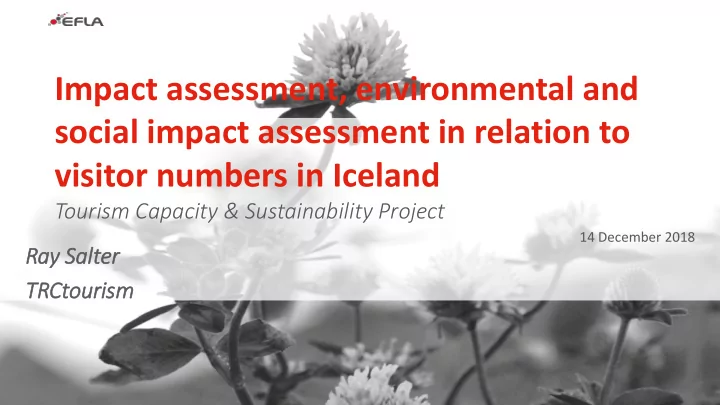

Impact assessment, environmental and social impact assessment in relation to visitor numbers in Iceland Tourism Capacity & Sustainability Project 14 December 2018 Ray Salter TRCtourism
Ray Salter TRC Tourism – Australia, New Zealand and many countries in the Pacific and Asia Previously General Manger, Ministry of Tourism in New Zealand Have worked on similar growth/infrastructure issues in NZ
This Presentation What has been happening in the world? Why Nýja Sjáland? What are some of the tourism issues in Nýja Sjáland Some of the responses to these issues The importance of this project to sustainability and tourism
Tourism Trends Early 2000’s - Environment issues became important 2008-2014 - Global Financial Crisis in many countries - Survival first and then growing tourism the priority 2014- to now - Cost of travel has fallen significantly - Rise of China and improving economies - Environmental concerns back - Broad sustainability back on the tourism agenda - What number and sort of visitor do we want?
New Zealand and Iceland: Similarities Our attractions are very similar: - Nature - Landscapes - Adventure activities Drivers of growth - Aviation growth and cost of travel lower - “cool destination” Economic growth in source countries - Result - New Zealand 7%CAGR - Iceland 25% CAGR (until this year 10%)
New Zealand and Iceland: Differences 4.5 Million people vs 350,000 people 27 Million sheep vs 800,000 sheep 268,000 Km2 vs 103,000 Km2 3.8M international visitors vs 2.2M Domestic Tourism 60% vs 10% 5% of GDP vs 8% of GDP Australia “short haul” 30% Rest of the World “long haul” 12 hour flight
New Zealand and Iceland: Common Issues For Iceland: Few members of my community For NZ: Strong Support for the benefits of benefit economically from tourism. tourism. In particular, economic benefits 40% Percent of responses 35% 30% 25% 20% 15% 10% 5% 0% Strongly Disagree Neutral Agree Strongly disagree agree 2017 (mean = -0.39)
New Zealand and Iceland: Common Issues Community concern about the number of visitors – attitude surveys Concern about the environmental effects of visitors in key locations Still some regions wanting more visitors The “social licence to operate” of tourism is being questioned
But attitudes do change Concern about pressure of visitors in New Zealand being too much is stabilising
Common Assumptions That while the current rates of growth are unsustainable over the long term, global growth is expected to continue That there is a mismatch between the visitor growth and the infrastructure to provide for these visitors The revenue from the additional visitors is not going to develop the required infrastructure That the destination needs to maintain the quality of the experience
Current Issues Pressure on National Parks Concern about authenticity of the product and experiences Concern about too rapid growth and the global growth situation – is it sustainable? Concern about the quantity and quality of infrastructure to support the number of visitors, especially in small communities Big lag in private investment to meet visitor demand – especially hotels and then the risk of a boom bust cycle Government slow to act on public infrastructure
Policy responses A new Government Strategy that emphases sustainability - - spread of benefits - quality of growth and profitability (value over volume) Changed government priorities – stronger emphasis on infrastructure provision to meet future demand ahead of the demand Strengthen education on tourism and for employment in tourism - Better data - especially regional information and how visitors move around the country and also domestic tourism information
Funding responses A new tax on international visitors at the border - 250Isk per visitor - Mechanism is an electronic travel approval - 50% to tourism infrastructure - 50% to nature sites Provincial Growth Fund - 85B Isk per year investment - Significant proportion going to tourism - Regional investment, not cities Differential pricing - Foreigners pay 2x what locals pay - Annual fee for locals = 2x what a foreigner does for one visit
Information responses Tiaki Promise – a steal of the Icelandic Pledge New Apps/information for visitors Focus international marketing on the regions No marketing of NZ as a summer destination Focus on source markets that deliver off season visitors
This Project A first at a National scale The first to actually gather data It integrates economic, social and environmental measures It will provide a framework to consider “what if questions” It will gather the most important information to make infrastructure investment decisions It will link to international information It will not provide all the answers but it will assist
Wider Bay of Plenty Prioritization Matrix for Tourism Infrastructure Actions Skills and Training Air High Roading Connectivity Connectivity Intra regional Public Sector National roading Visitor Public Land Improvements Responsibility . Accommodation Recreation/Conservation Improvements Upgrade Impact Public Sector Local Aviation Government Infrastructure Responsibility . Tourism Product Development Digital Mixed responsibility Capability and Public Connectivity Transport Private Sector Three Waters Responsibility . Infrastructure Low Low High Effort The size of the bubbles represents the relative costs of the actions on a regional basis
D.4.3 – Economic Benefits Few members of my community benefit economically from tourism. 35% 30% Percent of responses 25% 20% 15% 10% 5% 0% Strongly dasagree Disagree Neutral Somewhat agree Strongly agree 2017 (mean = -0.08)
Recommend
More recommend